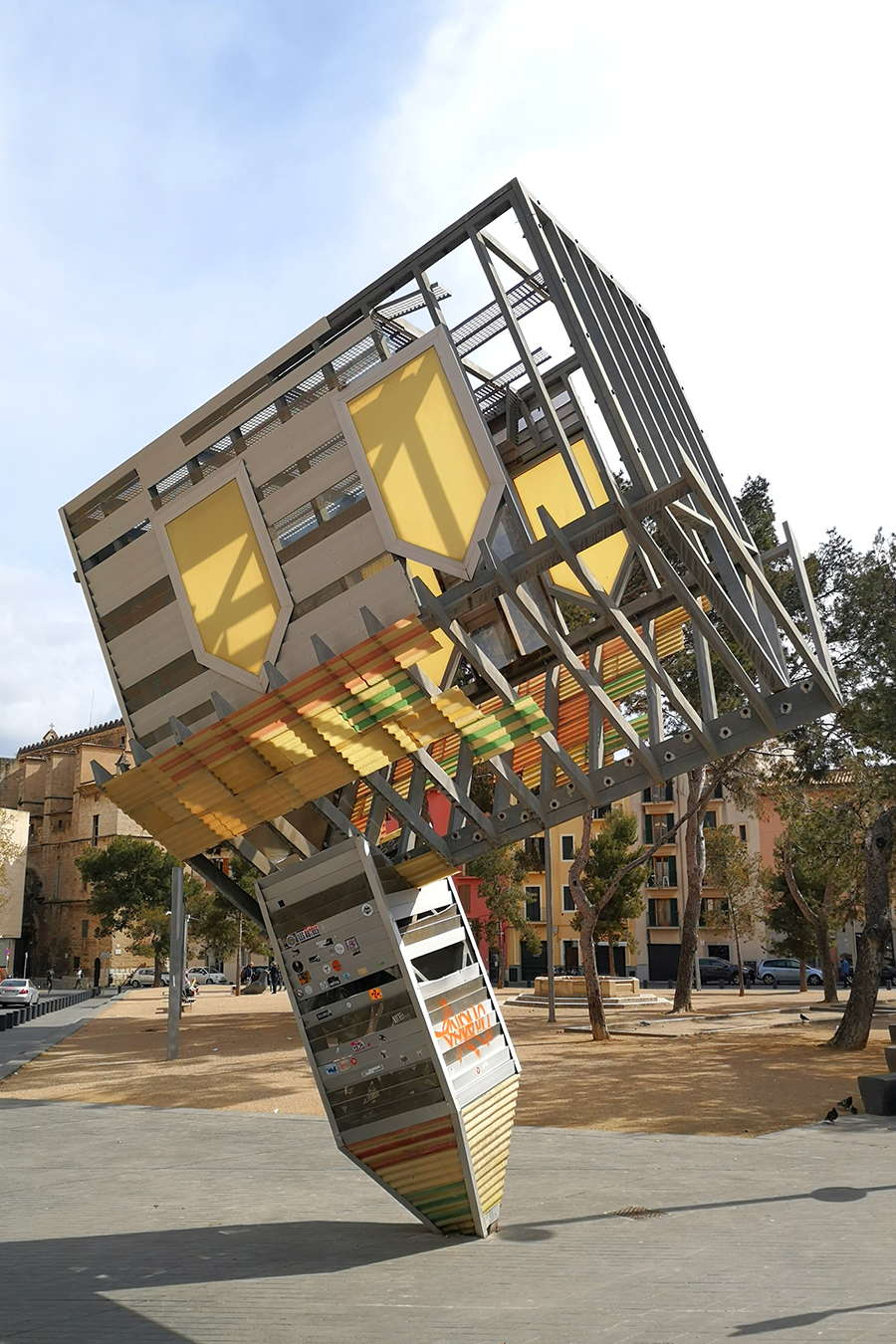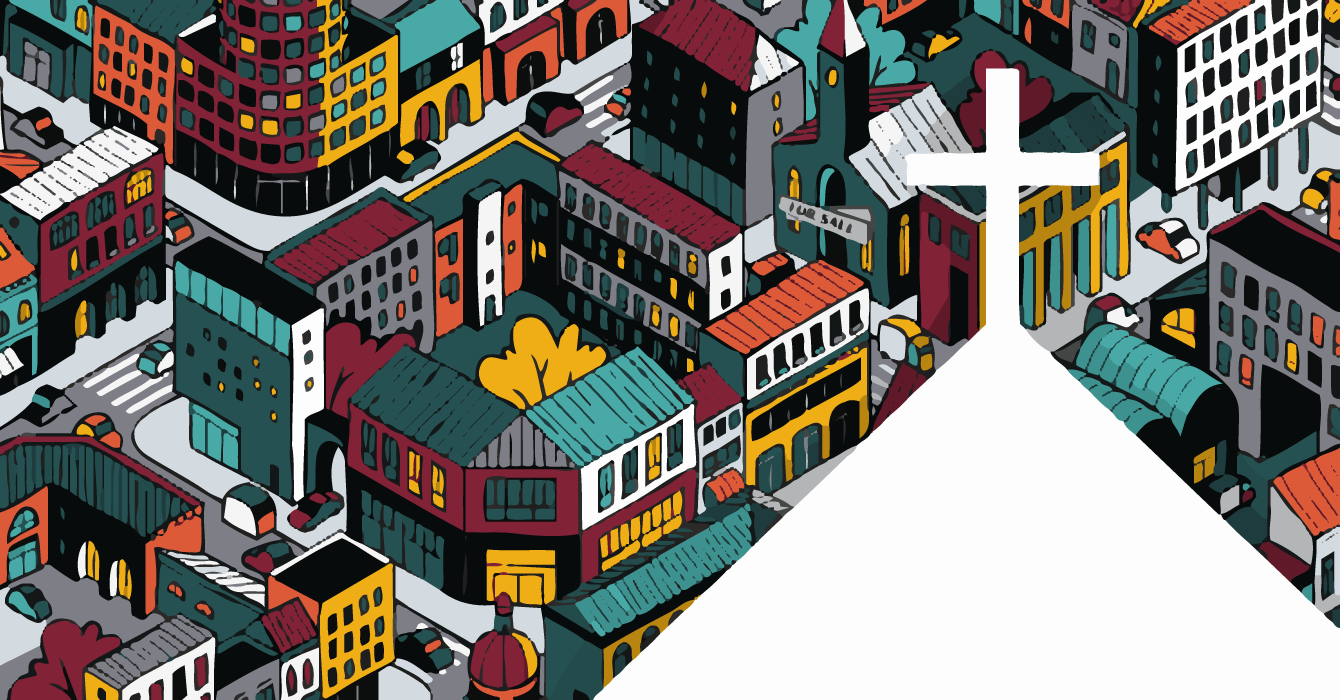Palma is a vibrant city on the island of Mallorca in the Balearic Sea. In this part of Spain, the ocean is turquoise and the cliffs are rugged. The buzzing town is full of sidewalk cafes, churches that call you in for relief from the heat, and shops down every alleyway. I visited there earlier this year, in search of time away, taking space to reflect and dream.
One day while walking through the city, I came across a church turned completely upside down. This representation of a New England-style church rests on the point of its steeple, tilted at an angle, just sitting there in the middle of a little public square. I didn’t know it then but later discovered that it’s a work of art by American artist Dennis Oppenheim.
I stood gathering my thoughts and watched as other people encountered this piece of art. Some actively discussed it. Others just lingered a while, took photos or walked right past.
What a great visible depiction of what is going on right now.
Oppenheim’s early work focused on epistemology, questioning the nature of art and wrestling with concepts of context and place. His work progressed to look at larger social and political movements, aiming to provoke questions in the viewer. He certainly did that for me with this large-scale depiction of an institution in flux.
The work is called “Device to Root Out Evil,” and as you can imagine, the various versions of the sculpture have been controversial. Some Christians have even gone so far as to call it blasphemous. Others say it isn’t blasphemous at all but fun, provoking questions, debate and conversation. People of all generations are engaging with it.
Fundamentally, the sculpture provides a change in orientation, literally and metaphorically. For some people, this feels disturbing. But I’m not sure that is a bad thing. Being disturbed or disrupted might be just the gift we need in the church.
A shift is happening in how churches use their buildings and land right now. Some see it as a moment of crisis, but others (myself included) see it as an opportunity.
Churches once centered our towns and our lives; so much happened inside the building. But now, as people affiliate and live out their spiritual lives differently, we are experiencing a change of orientation. Instead of moving toward the center as we knew it, we are drawn outward.
“Constructive disruption” is a favorite term of mine. It is about shaking things up, changing in a meaningful way, for transformative impact. Many forces are shaping the church — people are gathering differently to get their spiritual needs met, the economic models of congregations are changing, buildings are lying underutilized, deferred maintenance is catching up with many congregations and communities.
However, the needs of people haven’t changed, nor has the power of the Spirit. This is a moment in which the way we do church is transforming. The disruption this is bringing can be constructive: as the way we use our buildings changes, we can build new pathways for the Spirit to touch people’s lives in powerful ways. And as we do, I believe we will see the church becoming a force in reshaping our cities again. Our churches are being turned upside down.
What does that look like? It might be a café on a main street serving 700 people a week with life-affirming support groups, a nonprofit training young adults to integrate soulful practices into daily life, or a seminary turning into a regenerative farm. Each of these examples disrupts church-as-usual to construct alternative pathways for the Spirit’s work.
Many Gospel stories illustrate moments of disruption: when the woman with an illness touched the bottom of Christ’s robe, when the father asked Jesus to come and heal his dying son, when the friends lowered the paralyzed man into the house where Jesus was teaching. Each of these interactions led to healing and wholeness. These were moments of profound witness. Everyone around Jesus thought he should be somewhere else or be doing something else when these instances happened, but Jesus’ focus was clear. He leaned into the disruptions, he was present and responsive, and good things happened.
A favorite scripture of mine is Acts 17:6 — “These are the men that have turned the world upside down [with the gospel].” It seems to me that constructive disruption can be a gift and a useful tool.
Like the folks who are uneasy at the sight of an inverted church building, we might feel disturbed by these changes. How can we respond constructively to disruption? I have some suggestions:
- Slow down or even stop. This is countercultural in our accelerated age, when everything seems to be going faster and faster.
- Wait and watch. Once you slow down, you start to see different things, different people, different opportunities. Be patient.
- Get curious and ask questions. Questions help us make connections and understand what’s going on. There’s a great quotation attributed to Henri Nouwen: “Answers before questions do damage to the soul.” Too often, we think we have the answers without first asking the questions.
- Identify the need. In an age of short-term thinking, we can miss the depth of people’s needs. Often, the needs in our community are complex, but seeking to understand them will help our own transformation.
- Be responsive. Adapt and experiment when it’s time to act.
There is a huge opportunity in this moment for congregations to be bold — to turn themselves upside down. If people can respond constructively, they will be transformed by meeting the needs of their community in new ways.
I believe we will see the church becoming a force in reshaping our cities again. Our churches are being turned upside down.
















